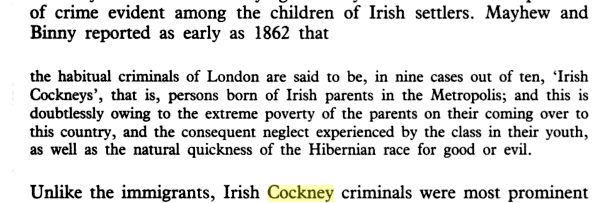| Irish Forums Message Discussion :: How Irish immigrants became the Cockneys of London |
   | Irish Forums :: The Irish Message
Forums About Ireland and the Irish Community, For the Irish home and Abroad. Forums include- Irish Music, Irish History, The Irish Diaspora, Irish Culture, Irish Sports, Astrology, Mystic, Irish Ancestry, Genealogy, Irish Travel, Irish Reunited and Craic
|  
|
How Irish immigrants became the Cockneys of London
 

|
|
|
| Irish
Author |
How Irish immigrants became the Cockneys of London Sceala Irish Craic Forum Irish Message |
Boyle Bru

Sceala Philosopher
Location: Ireland
|
| Sceala Irish Craic Forum Discussion:
How Irish immigrants became the Cockneys of London
|
|
|
Before coming to here, I would not even had made a token evolutionary connection between the Irish and the old cockney culture.
Not until I read of how the typical 19th century cockney and costermonger trade most associated with the cockney of old, were actually typically Irish.
An Irish costermonger, however, is no novelty in the streets of London. "From the mention of the costardmonger," says Mr. Charles Knight, "in the old dramatists, he appears to have been frequently an Irishman."
Of the Irish street-sellers, at present, it is computed that there are, including men, women, and children, upwards of 10,000. Assuming the street-sellers attending the London fish and green markets to be, with their families, 30,000 in number, and 7 in every 20 of these to be Irish, we shall have rather more than the total above given. Of this large body three-fourths sell only fruit, and more especially nuts and oranges; indeed, the orange-season is called the "Irishman's harvest."
I know that cockneys in the east end of london are a thing of the past and the movies now. But the story is really interesting and it is a little known Irish story.
I knew from talking to the last of them who grew up in East London before the 1970's, (before the Asian immigrants arrived en masse) that the Cockneys were different to other Londoners, but I never thought to ask as to how and why.
There is a ignorance that imagines that the cockney were the originals and real white English, when nothing could be further from the real history of the cockney.
Anyway the theory espoused here that the Cockneys were moulded from 18th and 19th century poor foreign immigrants and that at the core, the very essence were the Irish immigrants, that is not theory because it turns out to be true.
Historical documents prove it.
The evidence that the Cockneys were Irish.
This cockney diaspora has been going on for centuries and accelerated with the relocation of Blitzed Londoners into Essex exile. But the process dates back to the 1840s and 1850s, with the obliteration of the Rookeries, a knot of fiercely working-class streets around St Giles-in-the-Fields. �The streets were narrow; the windows stuffed up with rags, or patched with paper; strings hung across from house to house, on which clothes were put out to dry,� wrote journalist and snob Thomas Beames in �The Rookeries of London� in 1832 of this maze of cockney-Irish tenements.
It was a notorious hotspot for thieves, beggers and prostitutes, but also the heart of cockney London, where rhyming slang was born, and home to �shopkeepers, lodging-house keepers, publicans, street dealers in fruit, vegetables, damaged provisions and sundries, sweeps, knife-grinders, doormat-makers, mendicants, crossing sweepers, street singers, persons who obtain a precarious subsistence and country tramps.� In 1842, St Giles was knocked down to make way for New Oxford Street. Between 1830 and 1880 an estimated 100,000 working-class Londoners were evicted during the building of Shaftesbury Avenue and the Holborn Viaduct. Although they were able to settle nearby, in Covent Garden and Whitechapel, a policy of social sifting had begun.
The Rookeries of London
Thomas Beames

The Irish in Britain, 1815-1939
By Roger Swift, Sheridan Gilley
Other sources
 
My East End A History Of Cockney London Gilda O'Neil
|
|
|
|
|
|
|
|
|
|












